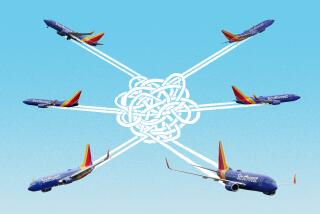Straighten Up and Fly Right
Bankruptcy conjures up images of torched credit ratings for ordinary Joes and Jills, with the only benefit being an end to hounding by creditors. But that logic can turn upside down when the bankrupt party is a billion-dollar business, particularly one as vital to personal and commercial life as an airline.
Of course, the Chapter 11 bankruptcy filing announced Sunday by US Airways Group is creating anxious moments for skittish ticket holders and loyal passengers with big frequent-flier mileage. Those consumers aren’t likely to get burned, but the pain will worsen for shareholders who’ve watched the stock price skid to $2.45 from a 52-week high of $18.32. Bankruptcy can conceivably lead to brighter days, however. Continental Airlines, for instance, used bankruptcy to cut costs, hone business plans and emerge stronger.
Bankruptcy alone won’t solve the industry’s problems. The Air Transportation Stabilization Board, created after Sept. 11, still has to ensure that troubled airlines retain access to needed credit. Some form of assistance clearly is necessary. Even before Sept. 11, US Airways and United Airlines hoped to bolster their chances of surviving by merging. Regulators, though, refused to bless the deal.
Carriers have slashed flights and laid off a record number of employees, but Southwest Airlines is the only major carrier reporting profits. Lenders, worried that airlines won’t be able to repay loans, are balking when airline executives come knocking. This is where the board enters the picture.
US Airways, even in bankruptcy, seems on track to meet requirements for federal loan guarantees. The airline has struggled to cut costs, making it a good candidate to pay back loans that federal guarantees would make possible. The airline negotiated $1 billion in wage and work rule concessions from its unions and plans to use Bankruptcy Court to wring concessions from suppliers and lenders.
That brings us to United Airlines.
The nation’s second-largest carrier is lobbying fiercely in Washington for loan guarantees. But the airline still has a relative mountain of cash and has yet to attack operating costs that are among the industry’s highest.
United’s competitors are probably right in arguing that United’s first stop should be Bankruptcy Court, not the loan board. United is in a tough spot because employees hold a majority of the airline’s shares; they must start thinking like owners and recognize the need for painful concessions. Bankruptcy Court would force the tough decisions.
The airline industry lost a lot of passengers after Sept. 11, but the terrorist hijackings only accelerated a trend. Big airlines still struggle to match more nimble airlines like Southwest and JetBlue Airways that move passengers at less cost--and use the savings to undercut big airlines’ ticket prices.
Carriers that want loan guarantees should prove first that they’re cutting costs, pruning routes and shedding unnecessary staff--including management--without compromising safety. In short, they need to take hard steps so they can pay their bills. Airlines that don’t display that kind of determination shouldn’t get taxpayer-backed guarantees.
More to Read
Inside the business of entertainment
The Wide Shot brings you news, analysis and insights on everything from streaming wars to production — and what it all means for the future.
You may occasionally receive promotional content from the Los Angeles Times.










